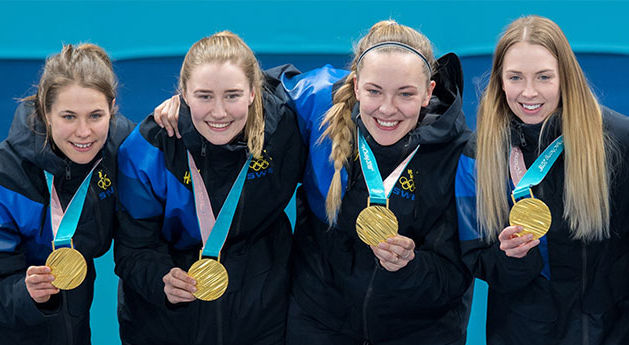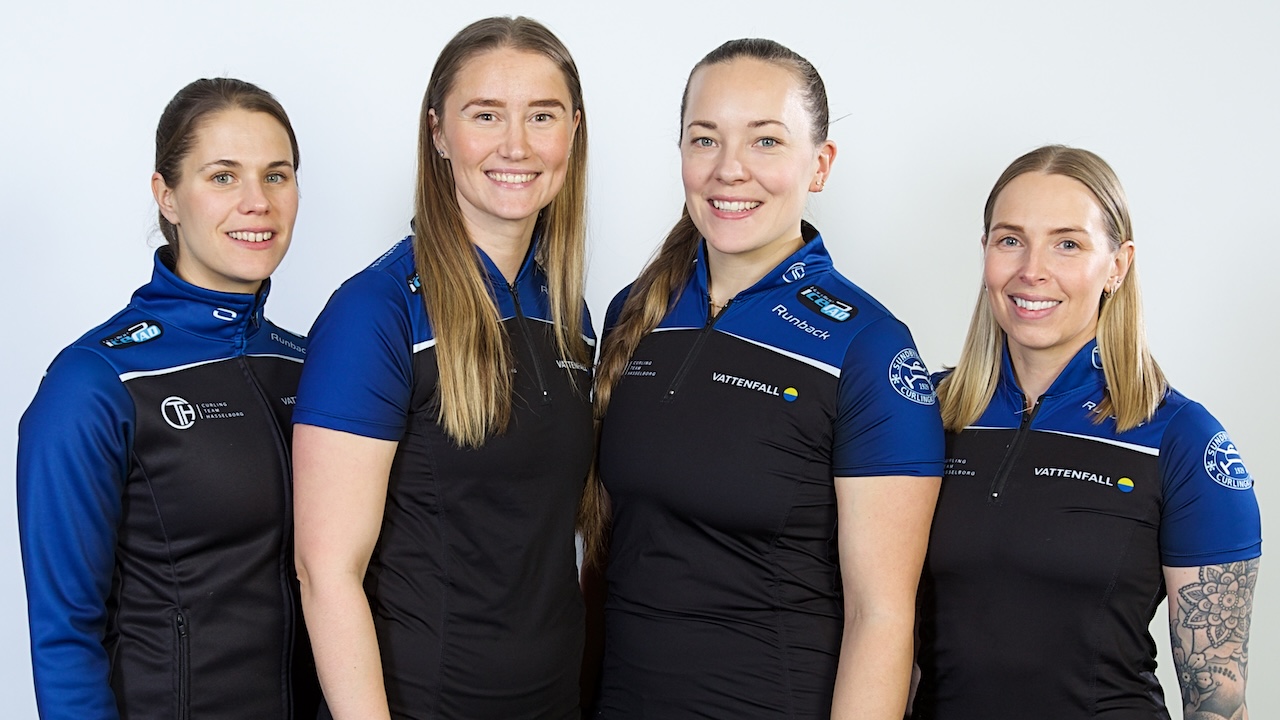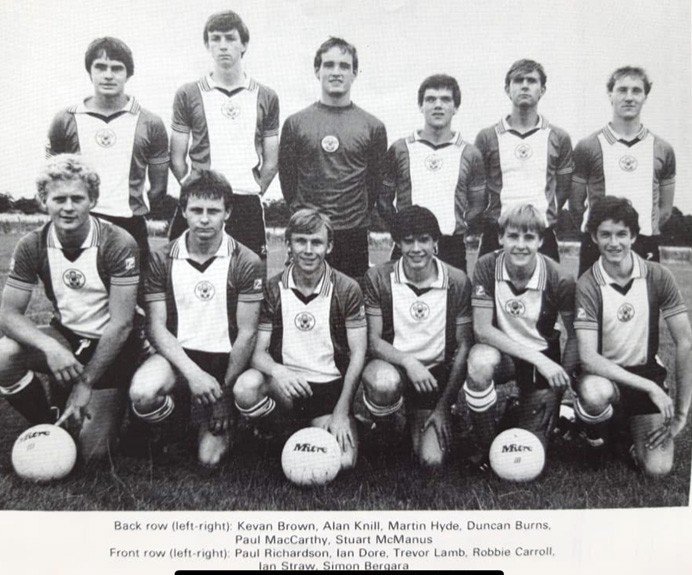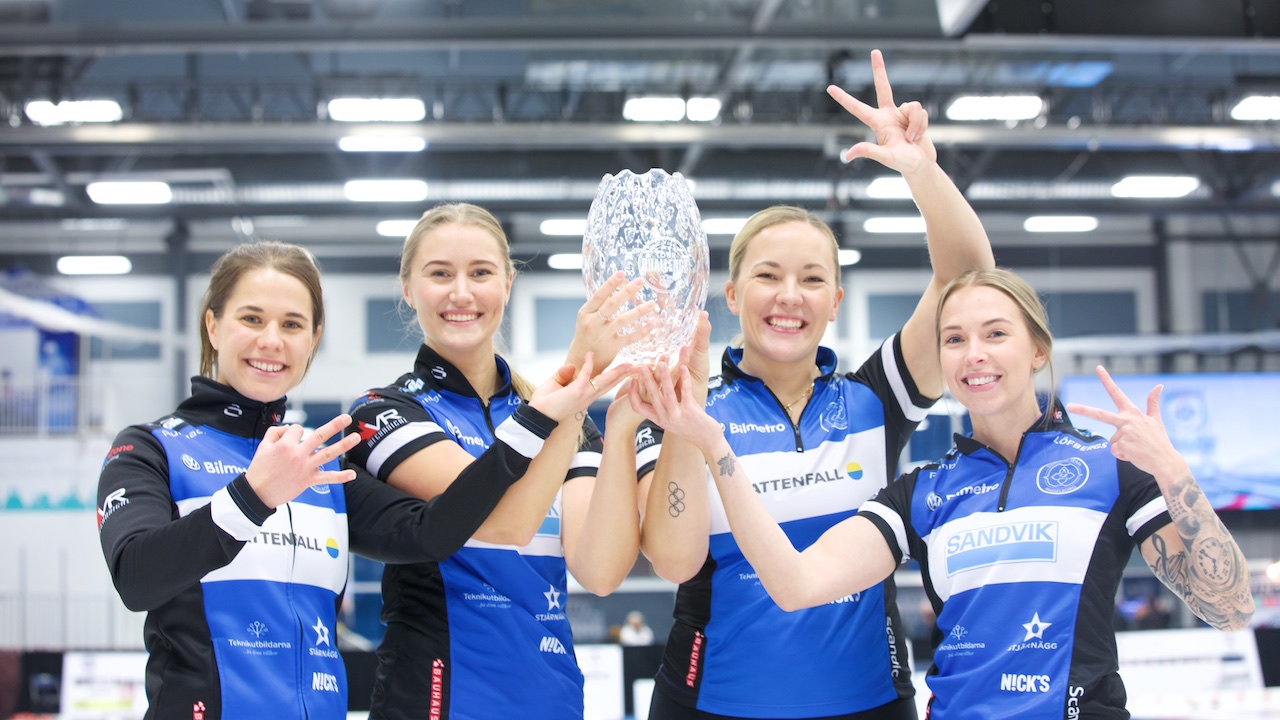Sweden’s Team Hasselborg was meant to be together
Sometimes, a team is just meant to be.
Consider Sweden’s Team Hasselborg, one of the world’s most successful rinks since they formed in 2015.
How’s this for fate: skip Anna Hasselborg and second (now vice) Agnes Knochenhauer were born on the same day of the same year (May 5, 1989) in the same city, Stockholm.
Same hospital?
“No,” they both laugh. But …
“I was supposed to be born at the same hospital but it was full,” said Anna. “She is a couple of hours older than me, as you can see,” Anna added with a big smile, nodding at Agnes. “The standing joke is that she took my spot.”
The irony, Agnes said, is that Anna “lives next door to the hospital. They had to drive further away across the city.”
On top of that, they both have the same middle name – Ellinor.
“Oh yeah, they were meant to be,” laughed Sofia Mabergs, who plays front end for Team Hasselborg.
Well, sort of, Anna confessed. Originally, as juniors, she wasn’t sure she wanted Agnes on the team but her teammates convinced her to change her mind. “They made a good choice,” Anna said. “She proved me wrong very quickly and for many, many years.”
On the ice, Team Hasselborg may give off the impression they’re all business, coolly dispatching their opponents with clinical Scandinavian efficiency. But appearances can be deceiving.
Off the ice, the team members are warm, friendly, funny and quick to laugh. And they love Canada, where they spend half a dozen weeks or more each year during the curling season.
“Canada feels like a second home,” said Agnes. “We get recognized here more than we do at home so it’s always super fun to come here. People will whisper to me ‘I’m cheering for you but don’t tell anybody.’”
“We love coming here,” Anna added. “We do feel a little bit like it’s coming home when we’re here.”
In their early days, the team didn’t have a lot of money so they’d contact organizing committees of events here in Canada and ask for help, like finding a billet family.
“Everyone is so friendly, they’d open up their homes for us,” Anna said. “We always felt so welcome.”
So much so that Sofia has decided to make Canada her permanent home.
Last summer, Sofia moved to Saskatoon to be with her partner, Brady Scharback, who is also a curler. They’ve bought a house there and she will be applying for permanent residency in Canada.
“I love Canadian people,” she said. “They’re so nice, so friendly.”
There’s one big change from Sweden, however. Sofia grew up in a small town near the Norwegian border surrounded by trees and mountains. Both of which are in short supply in Saskatchewan.
“I’m, like, can I see a tree somewhere? No, I can’t,” she laughed.
Sofia’s move to Canada and the temporary absence of vice Sara McManus, who delivered a baby boy on Jan. 3, has shaken up Team Hasselborg’s routine this season.
Agnes has moved from second to vice and Sofia has shifted from lead to second.
They can’t practice as much together now and they’re trying to figure out how to stay longer in Canada between events or for Sofia to return to Sweden earlier for European events.
Anna and Agnes practice during the day back in Sweden “and then pick up the kids at 3 o’clock,” Anna said.
“We see each other more than we see our husbands,” Agnes added.
Isn’t Sofia afraid her teammates will be talking about her behind her back in Sweden? “No, they love me too much,” she grinned.
“I have said as long as I curl, she’s mine,” Anna added. “We don’t want to let her go that easy.”

Team Hasselborg since 2015, by the numbers:
- 2 World championship silver (2018, 2019)
- 2 European championships (2018, 2019)
- 2 Winter Olympic appearances
- 1 Olympic gold medal (2018), 1 bronze medal (2022)
- 8 Grand Slam of Curling titles

Curling was a natural fit for Anna as a child. Her father, Mikael, and uncle Stefan played together at the international level as vice and skip, winning the silver medal at the 1985 world championships in Glasgow. They lost to Al Hackner’s rink from Thunder Bay in the final.
“I basically grew up in a curling rink,” Anna said.
Same for Sofia. “Basically, I was born in a curling rink,” she said. “I was in the shoes from the start.”
Agnes picked up the sport when she took part in a school-related curling clinic. And the clinic’s instructors? Anna’s parents, of course, in another twist of fate.
While Sweden has produced top international men’s and women’s teams for decades, the sport still lags behind in popularity.
There are about 50 clubs nationally and about 3,000 to 4,000 curlers at all levels and ages.
Anna and Agnes’ home club is Sundbybergs on the outskirts of Stockholm. With 130 members, Agnes said, it’s one of the country’s biggest clubs.
Being a world and Olympic champion doesn’t cut them any slack, however. At the start of the season, Anna was out with other volunteers at 6 a.m. flooding the ice.
Agnes said that most clubs in Sweden don’t have staff. “You make your own ice,” she said. “You scrape your ice before you practice and a lot of people don’t even do that. They just pebble and play.”
“We are all actually decent icemakers on this team,” Anna said. “The culture is different, yes, but it’s also a very unique, warm, nice culture where you all pitch in. It doesn’t matter if you’re an Olympic champion.”
The immediate goal for the team is to go through the current four-year cycle leading up to the 2026 Winter Olympics in Italy and then they’ll have another discussion about the future.
“Four years is a long time,” said Agnes, “but at the same time, it goes super fast.”
Team Hasselborg tells us why they love curling
Anna Hasselborg (skip):
“The strategic part is a big reason why I love it. I played lots of different sports growing up but when you’re out on the ice, you’re like your own coach out there, putting up a plan and trying to fulfill it. I love the feeling of keeping your emotions in control and knowing when to turn the heat on. The individual part mixed with the team part is such a cool part of the sport.”
She also loves the responsibility of having the last two shots of each end fall on her shoulders. “I think that is my drug, 100 per cent. I just kick out of the hack and give it some kind of good chance to make the shot and then it’s up to the team to make the best out of that shot. One thing we do so well on this team is that everyone is 100 per cent responsible for every shot. But I definitely love being the person who is the one who kicks out last.”
Agnes Knochenhauer (second):
“It’s the combination – you have to get all the pieces together with some other players. It’s pretty individual what you do on the ice but you have to merge it together to make it really good. The communication is so important. It’s tough and we like stuff that is tough.”
Sofia Mabergs (lead):
“You get so intimate with this team because we’re only four or five. We get so close – the communication, the strategy, the small talks beside the sheet or after the game. Those small things you do close together.”
Team Hasselborg tells us what’s weird about Canada
Canada is like a second home to Team Hasselborg, where they spend several weeks each year. And Sofia Mabergs has taken it a step further – since the summer, she’s been living in Saskatoon with her partner, curler Brady Scharback.
But that doesn’t mean they don’t find some things about Canada odd.
“Getting screeched in, that was weird,” said Agnes Knochenhauer, currently playing vice because Sara McManus is away after having a baby on January 3.
For the uninitiated, getting screeched in is a fun unofficial Newfoundland ceremony that makes a visitor to the province an honorary Newfoundlander.
It involves repeating a few Newfoundland sayings, drinking a shot of Newfoundland’s Screech rum and then kissing a cod fish on the lips.
The team also noted that Swedes are more reserved than Canadians.
“We are not as talkative as Canadians are,” said skip Anna Hasselborg. “You could be standing in a grocery store in Sweden and you just pay and go.
“But here, you talk about the weather, how your games are going, why you played that shot in the eighth. That is definitely weird.
“In Sweden we nod and then we go,” Anna said. “We don’t open our mouths.”
“In Sweden if you recognize someone you whisper ‘Oh there she is,’” Agnes added. “But here, they’re like ‘Hey, hello’ and they approach you. No one would do that in Sweden. “
“It’s weird but it’s good weird,” said Sofia.
And of course, there’s the sheer size of Canada, which is more awe-inspiring than weird.
“Some of my friends in Saskatchewan haven’t even seen the ocean,” said Sofia.

Team Hasselborg’s Scottish twist
Let’s see, we have Hasselborg, Mabergs, Knochenhauer and … McManus.
One of these things is not like the other.
You may have wondered about the Scottish-sounding name of Team Hasselborg’s vice, Sara McManus, who is currently away from the team after delivering a baby boy on January 3.
Sara’s father is Stuart McManus, who was a professional soccer player originally from Falkirk, Scotland.
After playing for Southampton of the English First Division in the mid-1980s, Stuart moved to Sweden and played several years for a team based in Gothenburg, where Sara was born in 1991. Stuart then played for a couple of Norwegian teams before returning to the Gothenburg-based team for another eight seasons.

